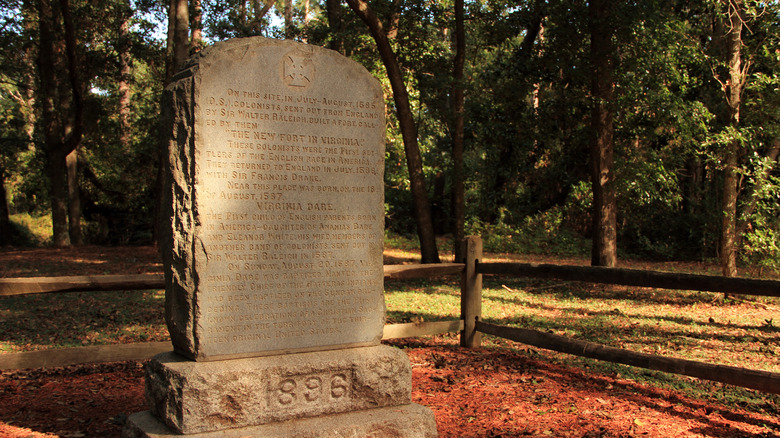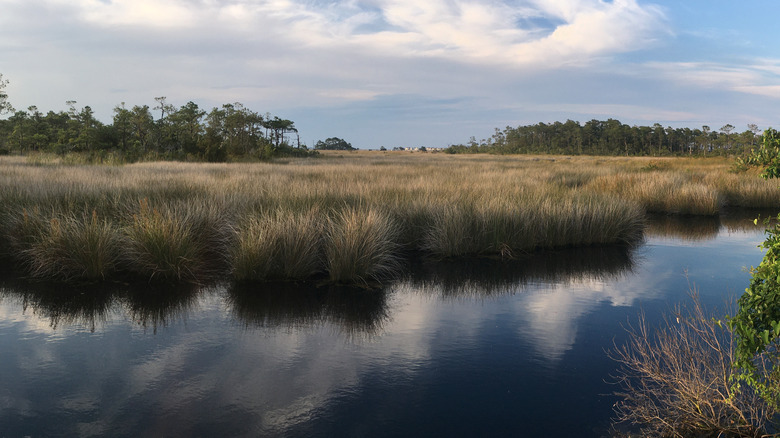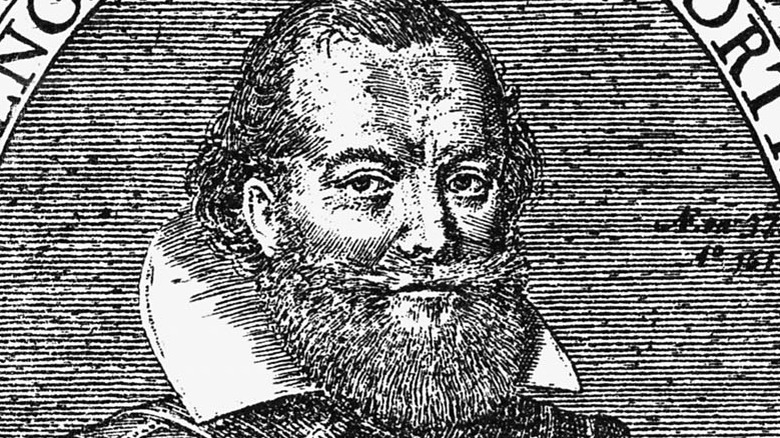The Biggest Lost Colony Of Roanoke Theories: What Really Happened?
In August 1587, a group of just over 100 English colonists founded a small settlement on Roanoke Island off the coast of modern-day North Carolina, according to History. That year, one of the settlers sailed back to England to gather more supplies. When he returned to Roanoke, three years later — he had been delayed due to a naval war between Spain and England — he found the settlement abandoned. The only clue he found to the disappearance of the colonists was a word carved into a wooden post — "Croatoan" — and another three letters, "CRO," carved on nearby trees.
You may have heard this story in history class, but what actually happened to the settlers, and what did that word mean? Though some explanations are more plausible than others, this mystery still has no definitive answer. Historians believe that the settlers likely interacted with a nearby Native American tribe, according to Britannica, but beyond that evidence, the ultimate fate of the colonists isn't clear, and may never be settled.
Croatoan: One word, two meanings
To the colonists of Roanoke Island, the word "Croatoan" would have likely referred to a nearby indigenous tribe, the Croatoan people, with whom the colonists had cordial relations. It also was the name of the island they lived on, which is today known as Hatteras Island (via History). This has led to the most common theory about where the colonists went — to live alongside the Native Americans on Hatteras Island.
The scant archeological evidence that exists may support this theory. A 1709 log by an Englishman told of Indigenous Carolinians who could read English, according to The New York Times, though the accuracy of this account is debated. Other accounts by early settlers spoke of blonde, blue-eyed Native Americans in the area, or of indigenous tribes that claimed to have white ancestors, according to the website History Collection. European tools from the late 16th century, such as a rapier hilt and a slate writing tablet, were found on Hatteras Island.
Most intriguing of all, Roanoke Island had not been quickly abandoned, and there was no sign of violence in the deserted village. The buildings had all been taken down intentionally, and the symbol the colonists were supposed to carve if they had to flee in distress — a Maltese cross — was nowhere to be seen.
Site X and confessed murders
But Native Americans taking in over a hundred Europeans would have been difficult, some scientists argue. "If experience is any guide, the adoption of Europeans into an Indigenous community would have been quite limited," said Dennis Blanton, an archeologist at James Madison University, to The New York Times. This has led some experts to speculate that the settlers actually split up, with some heading for Hatteras Island and others heading for a different, inland location, known as Site X. These colonists may have also been taken in by local tribes.
However, DNA testing of Native Americans indigenous in both areas has thus far not revealed any hidden Roanoke ancestors (via History Collection). This may point to a more tragic end for the colonists. According to Captain John Smith, the famous early settler of Jamestown in Virginia, Powhatan, a Native American leader in the area, said he killed the Roanoke colonists, who he claimed had been living with a rival tribe at the time.
The supernatural theories: wendigos, witches, and the white doe
As you'd expect, there have been spookier explanations for the disappearances as well. Needless to say, these theories are generally light on evidence. Some have blamed the disappearances on the wendigo, a kind of Native American monster with an insatiable hunger for human flesh. Though some fringe theories suggest that the colonists succumbed to starvation and cannibalism — such a fate befell some later colonists in Jamestown, Virginia — this would have been an ordinary tragedy, rather than a supernatural one (via National Geographic).
The anthology horror series "American Horror Story" posited that one of the settlers turned on the other colonists and massacred them at the bidding of a witch — a plot based on no historical evidence whatsoever (via CBR). But fanciful depictions of the colonists' fate have been common in American fiction for a long time. A poem written by Sallie Southall Cotten in 1901 spun the tale that Virginia Dare, a child among the settlers and possibly the first English person born in the Americas, was in her adulthood engaged to a Native American when a jealous witch turned her into a deer (via NCPedia). According to the poem, Virginia wanders the woods as a white doe to this day.



